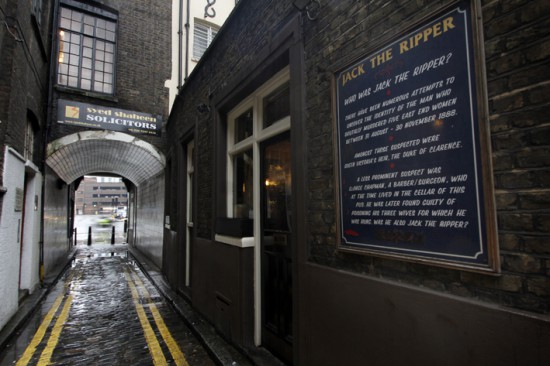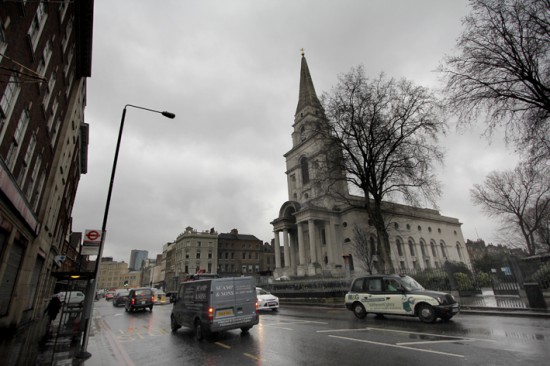The Whitechapel Murders
Dear Boss, I keep on hearing the police have caught me but they won’t fix me just yet. I have laughed when they look so clever and talk about being on the right track. Grand work the last job was. I gave the lady no time to squeal. How can they catch me now. I love my work and want to start again. You will soon hear of me with my funny little games. The next job I do I shall clip the lady’s ears off and send to the police officers just for jolly wouldn't you. My knife's so nice and sharp I want to get to work right away if I get a chance. Good Luck. Yours truly, Jack the Ripper.
It was one of the three among hundreds of letters that deserved some credibility in Scotland Yard. It was sent on September 27, 1888 and in it the epithet Ripper appears for the first time. A facsimile was published in the press of the time in the hope that someone would recognize the handwriting of the murderer but probably the only thing was that it generated more apocryphal letters will be sent taunting the police investigation. Another one was recognized as an authentic missive. It was sent on October 16 to George Lusk, leader of the Whitechapel Vigilance Committee, formed following the progression of the crimes. Along with the letter was added a box with a piece of human kidney which could not found with complete certainty the origin. In the letter later named From Hell the Ripper wrote: From Hell. Mr Lusk. Sor I send you half the kidney I took from one women prasarved it for you tother piece I fried and ate it was very nise. I may send you the bloody knif that took it out if you only wate a whil longer signed Catch me when you Can Mishter Lusk (sic). Press highlights made The Ripper became a legend.
London's East End was a good breeding ground for crime. Particularly the area between Whitechapel and Spitalfields was a miserable slum where taverns also functioned as brothels and small faults were common and homicide not rare, but the cruelty and atrocious mutilations that were committed against the prostitutes of the neighbourhood were unusual and absolutely execrable.

Yet it seems unlikely that the same person was responsible for all the crimes committed in the same area during those years in the turn of the century and maybe there was a certain mimetic effect. Eleven homicides committed between April 3, 1888 and February 13, 1891, were incorporated into the same investigation of Metropolitan Police under the heading of The Whitechapel Murders. But in fact only five are almost certainly attributable to the same person. They are known as the canonical five murders, because they maintain the same pattern with the same modus operandi. Also they were committed in a short length of time, between August 31, 1888 and November 9 of the same year. Were those of Mary Ann Nichols, Annie Chapman, Elizabeth Stride, Catherine Eddowes and Mary Jane Kelly.
Upon exiting Aldgate tube station we step on Whitechapel High Street. Following on right hand soon we get Saint Boltoph church which got some peculiarities. First, it housed the oldest organ in the city, dating back to 1676. Second, in the vaults was discovered the mummified body of a young man and instead immediate burial was decided to expose the body in order to collect a few pennies from any curious wishing to observe the oddity. But the relationship with the Ripper stays in the hookers who used to expose themselves in the church surroundings looking for customers. In 1888, the year of the crimes, Saint Boltoph was known as the church of the prostitutes.
Few steps beyond, and under the shadow of Norman Foster’s Gherkin, is the unremarkable Mitre Square. Here, on Sunday September 30, 1888, Joseph Lawende and his friends Joseph Hyam and Harry Harris were coming back home about one and a half when they saw in the darkness of Saint James Passage a couple spoken in intimacy. She was Catherine Eddowes Evans, a woman who was born 46 years ago in Graisley Green, Wolverhampton. In London roomed with John Kelly Cooney at 55 Flower and Dean Street, Spitalfields, and four and a half hours before had been arrested in Aldgate High for being in a state of intoxication rather evident. After testifying to the agent George Hutt was released with her hangover at one o’clock in the morning. Forty-five minutes later, fifteen minutes after it was seen by the three friends, police constable Edward Walkings blow his whistle from one corner of Mitre Square in front of the disfigured body of the unfortunate Catherine. The three friends were surely the only people who saw Jack the Ripper by one of his victims. He was described as a man with a stout moustache and dressed in a tweed jacket, red neck scarf and a deerstalker cap.
That fateful night was later known as the double event night, because when the constable Walkings received help was reported about the death, one hour earlier, of another woman, 44 year old, in the neighbourhood. Elizabeth Stride, Gustafdotter before married and from Swedish origin was found still bleeding by a janitor named Louis Diemschutz in a dark backstreet, Dutfield's Yard, along with Brener Street, now Henriques Street.
From Mitre Square, walking along Wentworth Street, where there is usually a street market, and going up by Bell Lane is White's Row. Previously called Dorset Street and said it was the most dangerous in the East End. At present there is a car park building where there were some alleys where rooms were hired by the night. One was Miller's Court, where lived an Irish redhead with blue eyes who respond as Mary Jane Kelly. He had come into this world 25 years before in Limerick, near the river Shannon. Four years before went to London as a prostitute. On Saturday evening, November 8 was seen on several occasions leading customers to her room. The next day John McCarthy, her renter, eager to collect the debt on his property, a pound and nine pence, sent somebody named Thomas Bowyer to raise the sum. He was knocking fruitlessly to Mary Jane's door. At 10 hours and 45 minutes or so, he managed to set aside a piece of curtain to slightly look inward. The horror was tremendous. When the police entered the room saw the young woman lying on her bed, lifeless. Their organs had been deposited on the furniture and her intestines blooded the walls. It was the most macabre Ripper job.
Leaving behind White's Row, Christchurch steeple stands on Commercial Street. Raised in 1714, the characters of this sad story should see it daily in their wanderings so as the tavern facing Spitalfields Market, the Ten Bells pub open since 1755 which neighbourhood prostitutes frequented with its customers. From the street the pub does not seem to have changed greatly. The double wooden door between two fluted columns and the worn marble step must be the same. From the remaining capitals poke male and female faces alternately. Above them a long wooden board with the same aged door colour Wines announces from immemorial time in gold types Wines, Truman’s Beer, Spirits. On September 8 dawn the bar was packed, drinking in a bar corner was Annie Chapman, a prostitute born in London 47 years before that used to sleep on a pension from the aforementioned and sordid Dorset Street. She was accompanied by a man bearing a stout moustache, a dark coat and a deerstalker cap. Next morning, John Davies, an Annie’s neighbour at 29th Hansbury Street, saw her lying on the backyard floor and believing she was drunk, had fallen on her face, until he saw the pool of blood and the viscera near her shoulder.
Mary Ann Nichols, 42, was the first of the so-called canonical Ripper victims. She was found on August 31. That night someone saw her leaving a pub near Brick Lane, Ye Frying Pan, heading to Thrawl Street to go to sleep. She had no money to pay the room so she returned to the area in search of customers. She was seen last time by her companions around two thirty in the morning on the corner of Osborn Street with Whitechapel Road. Charlie Cross made his way to his job in the Spitalfields market when he passed through Durward Street and saw what seemed like a bundle of clothes next to a door. Approaching he distinguished that it was a woman’s body. After giving notice appeared police constable John Neil and a doctor who certified the death.
Before canonical crimes were committed two prostitutes were murdered in Whitechapel. They topped the investigation list of victims and both were found in the vicinity of the current Aldgate East Metro Station, where there are still intricate alleys and shady courtyards that have probably changed little since Ripper Victorian nights.
In Osborn Street, near the last Mary Ann Nichols whereabouts, was brutally assaulted in the early hours of April 3 Emma Elizabeth Smith, 45. The next day she was send to the London Hospital in Whitechapel where she died of a peritonitis caused during the assault. Although included in the list of The Whitechapel Murders Smith's death does not seem to fit the modus operandi of the Ripper, that's the reason it is not considered one of the canonical crimes.

Martha Tabram, 39, was working with a colleague, Mary Ann Connelly, known as Pearly Poll, when contacted with two clients. They went to the entrance to Gunthorpe Street, which in those years was known as George's Yard, where a porch provides some privacy. Pearly Poll took his customer a little further, to a courtyard called Angel's Yard and now might be a stretch of Whitechapel Gallery. When she left for Aldgate, Pearly never saw again Martha. At four-thirty the young John Reeves left his room at George's Yard and almost fall down over the body of the unfortunate. She had been stabbed thirty nine times and her organs had been removed. Right there, beside the archway, opens from 1721 The White Hart Tavern. A sign written in chalk misleads promises of free beer. It is more or less fake, approaching, in small writing, it reads Free wi-fi... great Beer. Another poster reports that there lived Severin Klosowski, a Polish barber who called himself George Chapman and was accused of being the Ripper. He was not but he was not even a charity nun. He poisoned his three wives, acts for which he was finally hanged in 1903.
Other murders followed to canonical and were included in the record of the Whitechapel murders but have never been certain about the author and despite all the speculation and assumptions neither ever reached any definitive conclusion about who hid behind Jack the Ripper rubric.
© J.L.Nicolas



